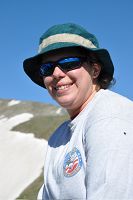Rachel Gabor defended her dissertation Friday, November 15th 2013
Rachel Gabor defended her dissertation entitled "A spectroscopic investigation of the chemistry of organic matter during biogeochemical cycling through the soil, groundwater, and surface water of Boulder Creek watershed" on November 4, 2013. Her dissertation was supervised by Diane McKnight and CZO committee members included Alex Blum, Alexis Templeton and Suzanne Anderson. Rachel graduated in December 2013 with a PhD in Environmental Studies.
Abstract:
The result of plant and microbial decomposition, organic matter (OM) is a complex, heterogenenous mixture of organic compounds found in all soil and aquatic systems. In soils, OM plays an important role in the carbon and nitrogen cycles and impacts the ability of soil to hold moisture. In aquatic systems, dissolved organic matter (DOM) is also integral to nutrient cycling, as well as attenuating light and complexing with metals. While OM is important for ecosystem functioning, DOM can cause toxic byproducts at water treatment plants. Concentrations of DOM have been increasing in many northern latitudes and an understanding of this phenomenon can help us better predict future water quality. Many hypotheses for the increase in DOM suggest that changes in the terrestrial landscape and hydrologic pathways are affecting DOM concentration and chemistry in aquatic systems. As part of the Boulder Creek Critical Zone Observatory, weekly samples of DOM in Boulder Creek as well as a first-order tributary were analyzed with fluorescence spectroscopy. In addition, water-soluble soil organic matter from the soil of Gordon Gulch, the first-order catchment was also analyzed. This multi-year dataset indicated that while Boulder Creek and Gordon Gulch both exhibit DOM dynamics commonly found in alpine ecosystems, the first-order stream is flashier, responding more quickly and dramatically to inputs from the catchment. Soil samples displayed a change in WSOM chemistry with depth that suggest a correlation between microbial input to the OM pool and oxidation state of that pool, indicating OM could be involved in microbial weathering of bedrock. Additionally, there was a noticeable difference in the chemistry of soil and stream OM, most pronounced in samples from the riparian zone. To understand the difference in stream DOM and riparian zone OM, two tracer studies were performed to investigate how in-stream processing alters the chemical character of soil organic matter. Chloride was used as a conservative tracer and freshly leached soil OM from the riparian zone as a reactive tracer. The continuous injection tracer was performed on a warm summer day after a year of high precipitation. The DOM chemical signature from the reactive tracer, as measured with fluorescence spectroscopy, attenuated quickly, and in-stream processing of the WSOM appeared to almost completely remove the tracer signal within 35 m. Modeling with OTIS showed considerable differences between reaches which where clear and reaches which were clogged with plant debris. A second, instantaneous injection, tracer study was repeated along a shorter stretch of stream on a cold fall day after a year of low precipitation. Similar results were seen, with the chemical signature of the reactive tracer disappearing quickly downstream of the addition. These results indicate that while catchment character is a significant driver of DOM chemistry, in-stream processing also has a substantial impact.
News Category:
RESEARCH |
PEOPLE |
EDUCATION/OUTREACH
Explore Further



